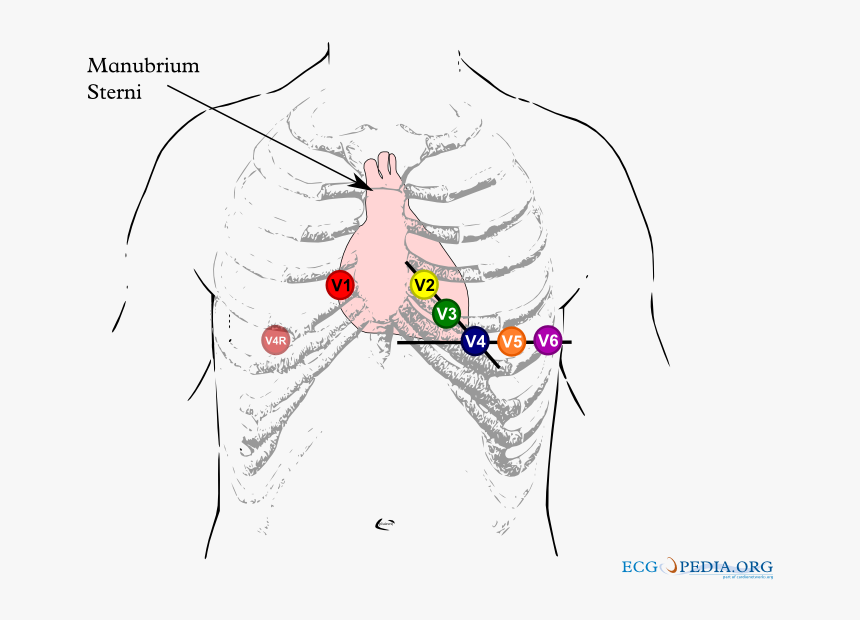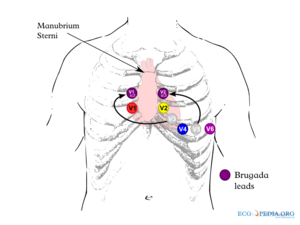Brugada_lead_placementpng 800 600 pixels file size. Imagepng This file is from a shared repository and may be used by other projects.

Positioning Of High Precordial Leads Hv1 To Hv6 For Procainamide Download Scientific Diagram
The ST segment in true BrEP is more downsloping than in early repolarization patterns.

. Careful placement of leads is essential to avoid false positive findings. Standard 12-lead ECG with V1V3 recorded from the fourth intercostal space and an additional. Evaluation of Brugada-like ECG patterns in athletes that are not clearly Type 1 or Type 2 should involve confirmation of lead placement clinical history including family history and application of published ECG criteria.
12-Lead ECG Placement Guide with Illustrations. Brugada Syndrome is an abnormal ECG Right Bundle Branch Block Pattern with coved ST elevation over the right precordial leads of V1-V3 which leads to ventricular fibrillation VF and sudden cardiac death SCD in patients with structurally normal hearts. Methods Ajmaline testing using 15-lead ECGs was performed in 183 patients suspected of carrying BrS.
Placement of the right precordial leads in a superior position up to the second intercostal space above normal can increase the sensitivity of the ECG for detecting the Brugada phenotype both in the presence or absence of a drug challenge. B Spontaneous type 1 Brugada ECG pattern in a 53-year-old man with aborted cardiac arrest implanted ICD and subsequently multiple appropriate shocks of the device. A positive Brugada-type pattern was defined as ST elevation in V1 or V2 consistent with a Type 1 2 or 3 pattern in the high-lead ECG.
It has been recognized as a clinical entity since 1992. Recently three criteria analyzing the ST segment and r width to identify true Brugada pattern ECGs have been described. To assess the feasibility and reliability of using high precordial lead ECGs in conjunction with three new criteria for identifying true.
Aims The authors sought to assess the value of the high right precordial leads RPL to detect the Type I Brugada ECG pattern in patients suspected of carrying Brugada syndrome BrS. The mean age of sudden death is 41 with the age at diagnosis ranging from 2 days to 84 years. The incidence of this disease is on the order of 5 per 10000 inhabitants and it.
Resting 12-lead ECG with standard precordial leads and ECG with precordial leads placed 1 Intercostal space above were performed after flecainide administration every 5 min for first 30 min and every 30 min thereafter until ECG became normal or upto 6 h. Brugada Syndrome is a rare inherited cardiac arrhythmia syndrome that is characteristed by a coved-shaped atypical right bundle branchpattern on a 12-lead ECG Type-1 Brugada pattern ECG and is associated with ventricular arrhythmias and sudden cardiac death. The Brugada syndrome is an autosomic dominant genetic disease.
It features large coved ST-segment elevations and T-wave inversions in leads V1V3. Placement of the right precordial leads in a superior position up to the 2 nd intercostal spaces above normal can increase the sensitivity of the ECG for detecting the Brugada phenotype in some. A programmed electrical stimulation was performed on our patient and a sustained ventricular arrhythmia.
Please see the file description page for further information. By contrast a type 2 Brugada pattern may often be found with these high leads are applied to healthy people especially in fit young males. Consider as cause of syncope in patients with family history of sudden death.
When gaining a 12-Lead ECG a configuration wherein the placements of V1 and V2 are positioned more cranially V1 ICS12 V2 ICS12 should be recorded as these leads can often give a clearer view of abnormal morphologies. Lead V1 from the 4th 3rd and 2nd ic. Diagnosis can only be considered appropriate with a positive ECG as well as at least one of the following.
ECG recordings and even more with placement of precordial leads V1V2 and V3 in the 2 nd and 3 rd intercostal space which may bring out a typical Brugada pattern and should be routinely performed when the diagnosis is suspected but is uncertain on a standard ECG and in screening of family members of BS patients. A Fractionated QRS complex in a 25-year-old asymptomatic male patient with BrS ajmaline-induced type 1 Brugada ECG pattern. Brugada syndrome is a rare inherited arrhythmic disorder causing an increased risk of syncope and sudden death due to ventricular fibrillation.
In addition to the standard 4th intercostal ECG lead positioning should also be higher on right precordial leads V1 to V3 at the higher intercostal space 2nd and 3rd. Brugada Type 2 Not Type 1 V1 and V2 may be placed in the 3 rd or even 2 nd intercostal spaces in order to elicit a type 1 Brugada pattern and is considered diagnostic. Whilst they are represented using standard lead configuration they are much less apparent than ventricular activity due to.
The Brugada syndrome may present with three different ECG patterns referred to as type 1 type 2 and type 2 Brugada syndrome ECG. The diagnosis of the characteristic type-1 or coved type Brugada ECG figure 1 is made from the right precordial ECG leads see also Wilde 2002. The Lewis lead named after Sir Thomas Lewis is an alternate placement that can be used to better view atrial activity in relation to that of the ventricles.
Ablation in Brugada Syndrome for the Prevention of VF Episodes. Sensitivity of the ECG can be increased with alternative placement of ECG leads to the intercostal space above V1 and V2 figure 2. An rSr pattern in leads V1-V2 can be observed when ECG leads are placed in the 2nd intercostal space.
The sensitivity of the ECG for Brugada syndrome can be increased with placement of ECG leads in the intercostal space above V1 and V2 V1ic3 and V2ic3 Electrocardiograms of Brugada patients can change over time from type I to type II andor normal ECGs and back. It is characterized by ST segment elevation in the right precordial leads V1-V2 and a high incidence of sudden death in patients with structurally normal heart due to ventricular arrhythmias 2. Brugada Syndrome is reported to be responsible for 4 of all sudden deaths and 20.
A typical baseline Fig A and positive ECG Fig B are shown. In many ECGs it can be rather difficult to assess P waves. Proven VF or VT.
A higher right precordial lead placement than the conventional position at V1V3 can also be used to unmask the Brugada-type ECG in subjects without typical ECG changes or unequivocal signs. When interpreted accurately an ECG can detect and monitor a host of heart conditions from arrhythmias to coronary heart disease to electrolyte imbalance. 80 of Brugada syndrome diagnosed only after a cardiac arrest.
Conclusion In our athletes without preexisting incomplete RBBB a Brugada-like pattern was easily obtained and highly prevalent with high placement of anterior precordial leads. The positivity was defined as inducible Type 1 Brugada pattern in atleast 2 right sided leads. In addition to the standard 4th intercostal ECG lead.
First described in 1992 by the Brugada brothers the disease has since had an exponential rise in the numbers of cases reported. Brugada Syndrome is an ECG abnormality with a high incidence of sudden death in patients with structurally normal hearts. Demonstration and unmasking of the type 1 ECG pattern at the higher lead positions also have diagnostic value for Brugada syndrome similar to its.
The most typical and diagnostic is type 1 Brugada syndrome. As a non-invasive yet most valuable diagnostic tool the 12-lead ECG records the hearts electrical activity as waveforms. Guidance on ECG lead placement.
84 KB MIME type.

How To Perform And Interpret Provocative Testing For The Diagnosis Of Brugada Syndrome Long Qt Syndrome And Catecholaminergic Polymorphic Ventricular Tachycardia

Brugada Syndrome Ecg Placement Hd Png Download Kindpng

Ecg Interpretation In Brugada Syndrome Sciencedirect

Brugada Syndrome Brs This Picture Displays The Ecg Trace Of A Download Scientific Diagram

Misplacement Of V1 And V2 Litfl Ecg Library Basics

Raviele Antonio On Twitter Figure Showing The Value Of High V1 V2 Leads Placement To Unmask Type 1 Brugada Ecg Pattern Dr Santangeli Abollmannmd Ecgtalk Adribaran Drfermingarcia Jorgeeromeromd Lluismont2 Manliomarquez Drjasonandrade

0 komentar
Posting Komentar